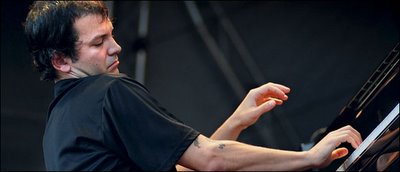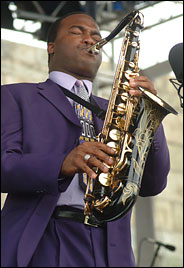 When the saxophonist James Carter takes the stage at the Iridium Jazz Club tonight for a five-night run, he will be flanked by several other musicians with ties to Jazz at Lincoln Center. But as on "Gold Sounds," a recent album, they will reach past jazz's standard repertory to the songs of Pavement, the influential 1990's indie-rock band.
When the saxophonist James Carter takes the stage at the Iridium Jazz Club tonight for a five-night run, he will be flanked by several other musicians with ties to Jazz at Lincoln Center. But as on "Gold Sounds," a recent album, they will reach past jazz's standard repertory to the songs of Pavement, the influential 1990's indie-rock band.  Never mind that Mr. Carter and his colleagues had barely heard of Pavement before making the record. The mere fact of their participation is the latest wrinkle in an unlikely phenomenon: the flirtation of jazz musicians with the world, or worlds, of indie-rock.
Never mind that Mr. Carter and his colleagues had barely heard of Pavement before making the record. The mere fact of their participation is the latest wrinkle in an unlikely phenomenon: the flirtation of jazz musicians with the world, or worlds, of indie-rock. Jazz and indie-rock, if not opposites, are distinctly unrelated; what they have most in common is a vastness that strains the terms of genre. It doesn't take much cynicism to suspect "Gold Sounds" and its label, the upstart Brown Brothers Recordings, of crossover designs. You would have to go back at least a generation to find a time when jazz claimed an audience as robust as indie-rock does today, and one as socially connected, fiercely protective and doggedly partisan. (On second thought, partisanship is another thing the two scenes have in common.)
Only a few jazz artists have successfully tapped into that audience. One, the pianist Brad Mehldau, was the headliner at the Village Vanguard with his trio last week; it's likely that a substantial portion of each full house was familiar with his past interpretations of Radiohead, a major-label band with indie-rock cachet. Another three-piece band, the Bad Plus, also reliably packs the Vanguard, and its base fits an indie profile more precisely; or at least, it includes a preponderance of 20-something white fans who don't otherwise visit jazz clubs. Last week, Mr. Mehldau's album "Day Is Done" (Nonesuch) was the second-ranked jazz recording on the college radio charts, as reported by CMJ New Music Report; "Suspicious Activity?" (Columbia), by the Bad Plus, had just slipped from third to fourth place. (On Billboard's general-interest jazz album sales chart, neither "Day Is Done" nor "Suspicious Activity?" ranked in the Top 10.) The new Bad Plus and Mehldau releases haven't yet been reviewed by Pitchfork Media, the online clearinghouse of indie-rock, but their previous albums have, and that's a distinction few jazz artists can claim. (A Pitchfork headline from September read: "The Bad Plus Make Jazz Cool Again With Album, Tour.")
Mr. Mehldau has never endorsed indie-rock per se; when he reaches beyond standards and original songs, he overwhelmingly favors pop of an earlier vintage. And although the Bad Plus has performed Nirvana's "Smells Like Teen Spirit" and the Pixies' "Velouria," its latest album almost exclusively focuses on original material. If it was repertory that first brought in new listeners, something else persuaded them to stay.
In the case of the Bad Plus, that something could be many things - explosive energies, aggressive touring, even an artfully disharmonious sense of style - but the members of the group tend to cite old-fashioned values like honesty and commitment. "Indie-rock audiences are zealots, hard-core," said David King, the band's drummer, who is a veteran of more than a few Minneapolis indie bands. "I think they recognize that there's something in the chemistry of how we approach this stuff, where we play it with a dedication to the actual intent of the music."
Mr. King was alluding not only to "Velouria," but also to the band's compositions. He and the bassist Reid Anderson have crafted many of the vaulting or brazen or yearning compositions in the Bad Plus arsenal; Mr. Anderson's songs, especially, borrow harmonic elements from both rock and classical music. Ethan Iverson, the group's pianist and token indie-rock naïf, contributes pieces with a sly audacity that suits the setting. "It ends up being about just communicating something with a lot of intensity," he said of the band's aesthetic, which in his case derives from avant-garde jazz heroes like Ornette Coleman (for whom the Bad Plus opened on Saturday night at the New Jersey Performing Arts Center).
Intensity has long been the connective tissue between the noisier extremities of indie-rock and jazz. Within experimental rock circles, it's de rigueur to claim inspiration from free jazz, especially the strenuous, squalling stuff of late-period John Coltrane. Sonic Youth and Yo La Tengo are two prominent groups in this lineage; both have collaborated, perhaps a bit too self-consciously, with free-jazz musicians.
The influence flows just as strongly in the opposite direction: jazz's avant-garde landscape is littered with proponents of, and participants in, various strains of independent rock. For instance, Nels Cline spent part of last year shoehorning his discordant but disciplined improvisations into the group sound of Wilco as its lead guitarist. (Despite what indie purists might argue, Wilco remains, at heart, an indie-rock band.) The bassist Trevor Dunn divides much of his time between the experimental jazz of his Trio Convulsant and the surrealist metal of the band Fantômas. Anthony Braxton, the august avant-garde composer, has professed his admiration for the underground industrial band Wolf Eyes; he joined the group on a festival stage this summer. Of course, John Zorn, the saxophonist and composer, has mined this territory as well; his East Village performance space, the Stone, is the place to witness such collisions.
It's a bit harder to locate a jazz hybrid that employs indie-rock's more consonant elements, but that may be changing. "I think there really is a movement afoot," said the trumpeter Shane Endsley of Kneebody, a punchy indie-fusion group that will perform at Tonic tomorrow, and at the Brooklyn Academy of Music on Friday. Last month at the 55 Bar, Mr. Endsley introduced a different project inspired by the loopy thrust of the band Deerhoof and the dark tonalities of the late troubadour Elliott Smith. The as-yet-unnamed group externalized these influences with a mid-register wash of vibraphone, Fender Rhodes piano and electric guitar; the feeling was of weightless suspension, in accordance with Mr. Endsley's designs.
A similar sensibility inhabits the music of Todd Sickafoose, a bassist who shares Mr. Endsley's Deerhoof fascination. (It's not the only thing Mr. Sickafoose and Mr. Endsley have in common; they're both associates of the indie siren Ani DiFranco.) Mr. Sickafoose was to play the Brooklyn club Barbès last night, with Mr. Endsley in his frontline, and Mike Gamble, another holdover from the nameless band, on guitar. Tonight, Barbès will play host to another young bassist, Eivind Opsvik, who in an e-mail message said he had been listening to the singer-songwriters Joanna Newsom and Sufjan Stevens; Mr. Opsvik's band, Overseas, which he describes as a rock band with jazz improvisation, will also perform on Sunday at the 55 Bar.
It's not hard to imagine bands like these - and Jim Black's AlasNoAxis, and Chris Speed's Yeah NO - striking a chord with the kind of loyal crowds that turn out for the Bad Plus, if not the curiosity-seekers that "Gold Sounds" indulges. For now, this music has the purest kind of indie cred: it's self-contained, self-promoted and mostly undiscovered. The musicians may not cover the songs of indie-rock, but they're immersed in its self-idealizing spirit.
By NATE CHINEN - nytimes.com
Technorati tag: Jazz
No comments:
Post a Comment